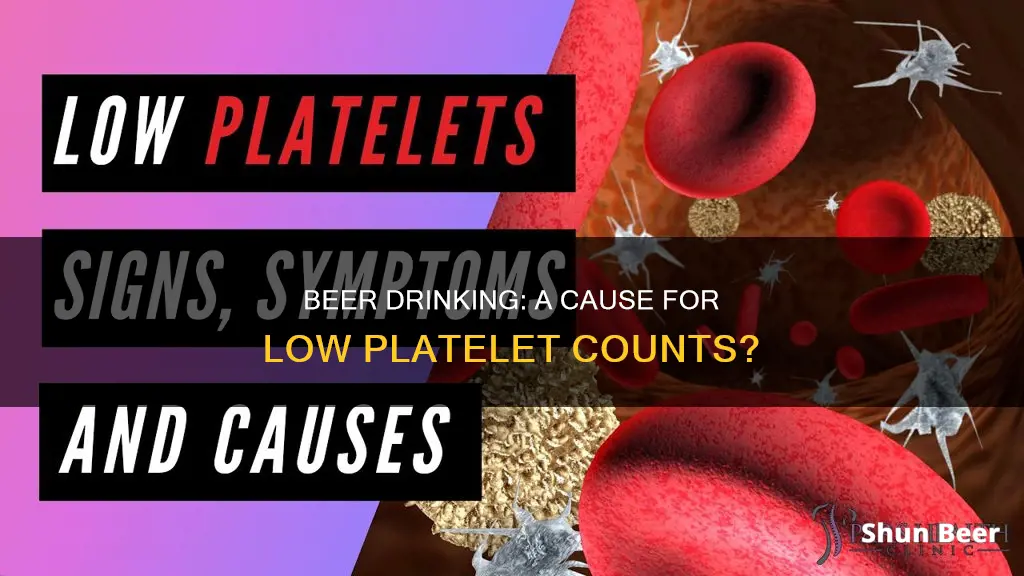
Alcohol consumption has been linked to various health effects, with research exploring its impact on platelet counts and function. While moderate drinking is believed to reduce mortality from cardiovascular disease, heavy drinking or binge drinking can have detrimental effects, including a potential decrease in platelet count, known as thrombocytopenia. This paragraph aims to delve into the relationship between alcohol consumption, specifically beer drinking, and its potential influence on low platelet counts.
| Characteristics | Values |
|---|---|
| Can drinking beer cause low platelets? | Heavy drinking may cause low platelets, but moderate alcohol consumption is believed to reduce mortality from cardiovascular disease. |
| Alcohol's impact on platelet count | Alcohol inhibits platelet function, and platelet count is often reduced in individuals with alcohol use disorder. |
| Alcohol's effect on platelet adhesion and aggregation | Binge drinking increases platelet aggregation and inhibits platelet adhesion, which can lead to detrimental health effects. |
| Moderate alcohol consumption | Moderate intake of alcoholic beverages is believed to protect against morbidity and mortality from coronary heart disease and ischemic stroke. |
| Binge drinking | Binge drinking is associated with increased mortality from all causes, including cardiovascular disease, due to its effects on platelet adhesion and aggregation. |
| Red wine consumption | Red wine consumption does not appear to have the same detrimental effects on platelet adhesion and aggregation as binge drinking. |
What You'll Learn

Heavy drinking may cause thrombocytopenia
Thrombocytopenia can be defined as a platelet count of less than 150,000/μL, which is below the normal reference range of 150,000–400,000/μL. Heavy drinking has been associated with a decrease in platelet count, and this knowledge is clinically significant in managing patients with alcohol withdrawal syndrome. For example, when platelet counts are less than 119,000/μL, the risk of withdrawal seizures or delirium tremens in alcohol withdrawal syndrome increases significantly.
The mechanism by which alcohol consumption affects platelet counts is still being elucidated. Alcohol use may impact the shape and functions of platelets. Studies have shown that alcohol can decrease platelet aggregation in response to most agonists, including thrombin, ADP, epinephrine, and collagen. However, in binge drinkers or alcoholics experiencing alcohol withdrawal, the response to aggregation, especially that induced by thrombin, is markedly increased. This rebound phenomenon may explain the occurrence of ischemic strokes or sudden death after episodes of drunkenness.
It is important to note that the relationship between alcohol consumption and platelet counts is complex and may depend on the amount and type of alcohol consumed. Moderate alcohol consumption, particularly of red wine, has been associated with reduced mortality from cardiovascular disease. In contrast, binge drinking is associated with increased mortality from all causes, including cardiovascular disease. The effects of alcohol on platelet adhesion and aggregation may contribute to these differences in health outcomes.
Beer and Medrol: Safe Mix or Health Risk?
You may want to see also

Alcohol's impact on platelet adhesion and aggregation
Alcohol can have a significant impact on platelet adhesion and aggregation, which are critical processes in hemostatic plug formation and thrombosis. Platelet aggregation is a complex and dynamic process where platelets adhere to each other at sites of vascular injury. While moderate alcohol consumption is believed to reduce mortality from cardiovascular disease, binge drinking is known to have the opposite effect.
Heavy drinking or alcoholism can cause thrombocytopenia, which is a decrease in platelet count below the reference range of 150,000–400,000/μL. Alcohol use may also impact the shape and functions of platelets. Binge drinking has been found to increase platelet aggregation and inhibit platelet adhesion to fibrinogen-coated surfaces. On the other hand, moderate alcohol consumption may decrease platelet aggregation in response to most agonists.
The effects of alcohol on platelet adhesion and aggregation can vary depending on the type of alcoholic beverage consumed. For example, binge consumption of red wine does not appear to increase platelet aggregation, whereas binge consumption of other types of alcohol does. The specific mechanisms by which alcohol affects platelet adhesion and aggregation are still being studied, but it is clear that alcohol can have a significant impact on these processes.
Lyophilized platelets, which are being studied as a potential hemostatic agent due to their long-term storage capabilities, have also been found to have paradoxical effects on platelet adhesion and aggregation. While lyophilized platelets promote platelet adhesion to a collagen-coated surface, they inhibit platelet aggregation. This inhibitory effect on platelet aggregation may be due to the presence of activated GPIIb/IIIa receptors on lyophilized platelets, which can interfere with the aggregation of untreated platelets.
Beer and Eliquis: A Safe Mix?
You may want to see also

Alcohol withdrawal and platelet rebound effect
Alcohol withdrawal can cause a rebound effect on platelet levels, with an initial drop in platelet counts followed by a rapid normalisation or even an increase in platelet numbers. This phenomenon is known as reverse thrombocytosis (RT).
During alcohol withdrawal, platelet counts show a gradual rise from baseline until the end of alcohol withdrawal. In a study by Fink and Hutton in 1983, platelet counts were estimated on days 1, 8, and 15 of alcohol withdrawal, and they did not report a decline in platelet counts. However, more recent studies have found that platelet counts can drop below the baseline in the first half of alcohol withdrawal (around day 4), followed by a gradual rise until the 10th day. This rebound effect can be influenced by the influx of newly formed thrombocytes into the circulation, resulting in increased platelet size and aggregability.
The rebound effect of alcohol withdrawal on platelet levels has been observed in both human and animal studies. In a study on rats, it was found that depriving the rats of alcoholic beverages for 18 hours was associated with an increase in platelet response. Similarly, in a clinical case, a young patient undergoing alcohol withdrawal experienced a transient elevation of platelet counts in the second week of withdrawal, indicating a potential clotting risk.
The mechanism behind the rebound effect is suggested to be related to changes in platelet structure and function during alcohol withdrawal. Platelets undergo a decrease in aggregation and thromboxane A2 secretion, which gradually returns to normal within 2 weeks of abstinence. Additionally, there is a normalisation of bleeding time and a rise in platelet serotonin concentration during alcohol withdrawal.
The clinical significance of the rebound effect of alcohol withdrawal on platelet levels is important, as it can impact the risk of thromboembolic disease and cerebrovascular insults. The increased platelet aggregability can lead to thicker blood and a higher risk of clotting, which can result in pulmonary embolism and deep vein thrombosis (DVT). Therefore, monitoring platelet levels during alcoholism and alcohol withdrawal is crucial for assessing individual clotting risks.
Beer and Sudafed: Safe Mix or Health Risk?
You may want to see also

Alcohol's effect on platelet function
Several studies have shown that alcohol consumption, whether moderate or excessive, can impact platelet function. The immediate effect of alcohol consumption is a decrease in platelet aggregation in response to most agonists, including thrombin, ADP, epinephrine, and collagen. This effect can last for several hours after ingestion. However, in binge drinkers or alcoholics undergoing alcohol withdrawal, the response to aggregation, especially that induced by thrombin, is markedly increased. This rebound phenomenon has been observed in rats and may explain the occurrence of ischemic strokes or sudden death following episodes of drunkenness.
The type of alcoholic beverage consumed may also play a role in platelet function. Studies have shown that binge consumption of alcohol increases platelet aggregation and inhibits platelet adhesion to fibrinogen-coated surfaces, while binge consumption of red wine does not have the same effect. Moderate red wine consumption has been associated with a decrease in the level of conjugated dienes, which are involved in lipid peroxidation. This suggests that wine drinking may not have the same detrimental effects on platelet function as spirit drinking.
While moderate alcohol consumption has been linked to a reduced risk of cardiovascular disease, binge drinking has the opposite effect. The differences in consequences may be due, in part, to the varying effects of alcohol on platelet adhesion and aggregation. Further studies are needed to fully understand the complex relationship between alcohol consumption, platelet function, and health outcomes.
Is It Safe to Drink Beer That's Two Days Old?
You may want to see also

Alcohol-induced thrombocytopenia
Alcohol use may impact the shape and functions of platelets. It has been observed that alcohol can affect platelet production, survival time, and function. Specifically, alcohol can cause a direct toxic effect on platelets, leading to a decrease in their count. This condition is generally benign, and clinically significant hemorrhage is rare. Thrombocytopenia in hospitalized alcoholics may also be caused by splenomegaly or folate deficiency.
The risk of alcohol withdrawal complications, such as seizures or delirium tremens, increases significantly when the platelet count is less than 119,000/μL. This knowledge is crucial in clinical settings, as it allows clinicians to make more informed decisions and highlights the importance of routinely collected blood test results on admission.
It is worth noting that the relationship between alcohol consumption and thrombocytopenia is complex. While heavy drinking can lead to thrombocytopenia, moderate alcohol consumption has been associated with reduced mortality from cardiovascular disease. Conversely, binge drinking is known to increase mortality from all causes, including cardiovascular ones. This is because binge drinking can increase platelet aggregation and inhibit platelet adhesion, which can lead to the formation of clots that prevent the delivery of blood and oxygen to tissues, resulting in infarction.
Do Beer Cozies Work? The Science Behind It
You may want to see also
Frequently asked questions
Heavy drinking may cause thrombocytopenia, a decrease in platelet count below 150,000 in a microliter of blood. However, moderate alcohol consumption is believed to reduce mortality from cardiovascular disease.
Heavy drinking refers to consuming large amounts of alcohol in a short period, often referred to as binge drinking. This typically involves drinking multiple alcoholic beverages in a single sitting.
Heavy drinking can lead to a condition called thrombocytopenia, characterised by a decrease in platelet count. This can increase the risk of alcohol withdrawal complications such as seizures or delirium tremens.
Studies suggest that moderate red wine consumption does not have the same impact on platelet rebound effect as spirit drinking. Red wine contains high levels of polyphenols, which may offer some cardiovascular benefits.
Low platelet counts, or thrombocytopenia, can lead to an increased risk of bleeding, the appearance of bruises, and in more severe cases, internal bleeding. If you suspect you have low platelets, consult a medical professional.







